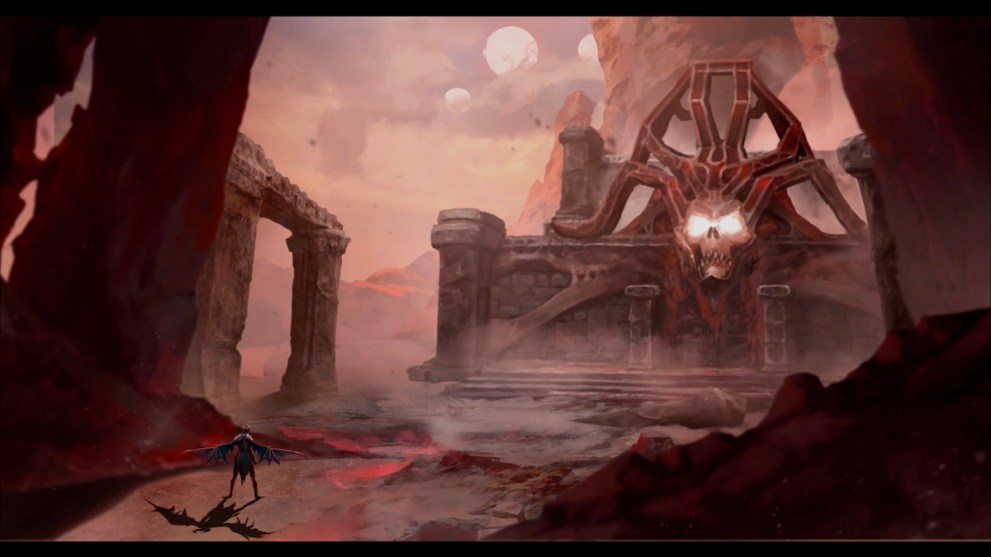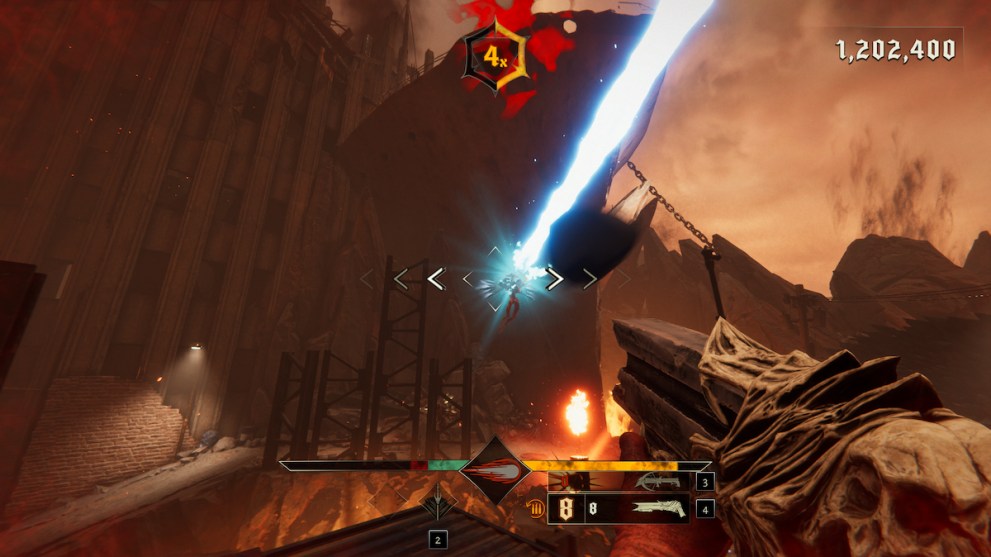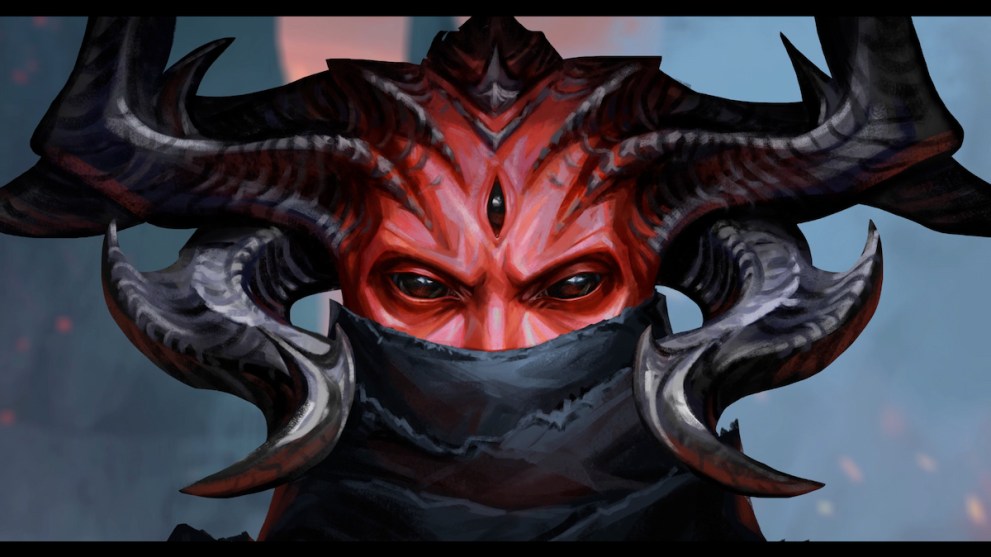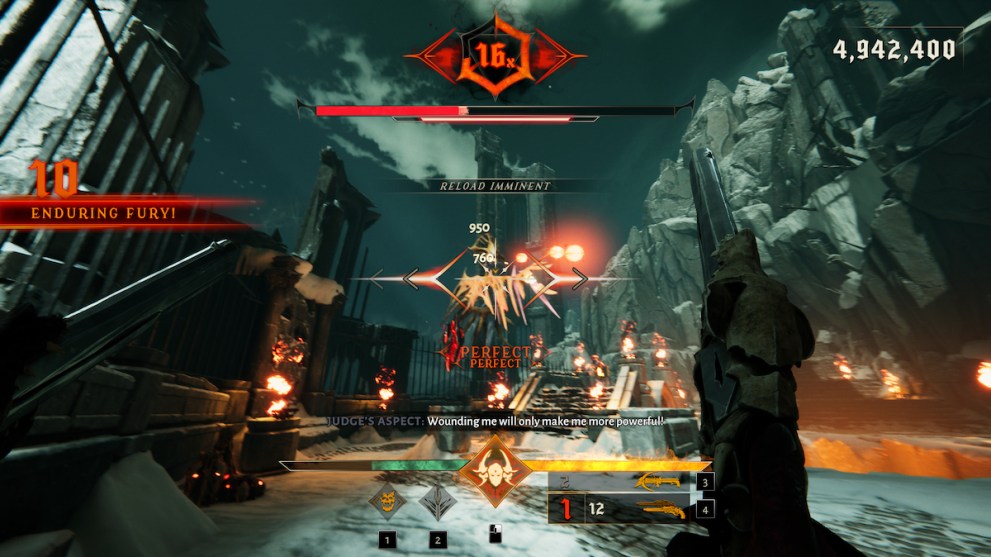Metal: Hellsinger on PC
It’s somewhat hard to believe that a game like Metal: Hellsinger hasn’t shown up sooner. Even putting aside their similar aesthetic stylings, first-person shooters and heavy metal music have shared a storied history.
One of the first notable crossovers of the two came in the form of the original Doom’s E1M1 level music featuring an iconic riff that closely resembled several earlier metal tracks, with Metallica’s “No Remorse” being the most notable potential source of inspiration.
It almost seems fitting, then, that Metal: Hellsinger owes much of its design elements and visuals to the newer Doom releases—a comparison that’s far more to the game’s credit than it is a criticism. More than that, it’s a comparison that can be felt in something as fundamental as the moving and shooting of the title, which is one of its greatest strengths.
Metal: Hellsinger puts players in control of the Unknown, a human-demon hybrid on a quest for vengeance against the Red Judge, ruler of Hell. Each stage of the game sees the Unknown traversing a different plane of Hell while mowing down hundreds of demonic foes to the beat of a heavy metal soundtrack.
It’s a simple setup, but one that works in the game’s favor by throwing the player into the thick of things as quickly as possible. To leave it there would be doing the story a disservice however, because there is very much a narrative here, and one that has more heart than you might expect. Of particular note is the narration of the story from the perspective of Paz, who recounts the journey with plenty of character and a thick southern drawl.
Perhaps the greatest aspect of the narrative are the cutscenes that display gorgeously detailed and lively artwork in the style of a graphic novel. I found myself consistently impressed with the artistry on display as these played out, and they worked wonders in drawing me into the experience.

When it comes to the gameplay of Metal: Hellsinger, it’s clear the team at The Outsiders possess a thorough understanding of what makes fast-paced, frenetic shooters as satisfying as they are. In addition to having access to multiple weapons with different situational uses, the Unknown can double jump, dash in any direction, and blast enemies away all while constantly moving at a high speed.
In the vein of older shooters, you have to be constantly moving in order to ensure your survival through an encounter. You can’t just thoughtlessly move and expect to avoid damage, though, as many enemies (especially ranged enemies) will use their attacks to cut off the Unkown’s path, aiming for where you’re headed rather than where you just were. You have to keep an eye on everything going on around you in Metal: Hellsinger, and the amount of enemy variations and attacks facilitate a high level of engagement as you lay waste to them.
In order to deal optimal damage, every shot from your chosen weapon must be to the beat of that stage’s song. If you time your shots correctly and they land on an enemy, you continuously build an ever-present points multiplier at the top of the screen. The presence of the song is minimal when you start the level, with softer guitars and drums that prepares you for the enemies ahead.

As you build the multiplier, the intensity of the track seamlessly increases (or decreases) in kind, ramping up more and more until you reach the highest tier, when the vocals kick in and properly complete the song. It’s incredibly satisfying when you stumble into a great gameplay streak and get rewarded with full-power growls as you continue reducing demons to a puddle and adding huge numbers to your score while you following the rhythm.
That being said, the strict adherence to the beat is something I can imagine being a point of contention for some with Metal: Hellsinger. None of the weapons available to the player have the ability to shoot during the off-beats of a song, and missing or mistiming shots is a surefire way to tank your multiplayer.
If you aren’t fast enough or accurate enough, this can lead to some disappointing situations where you’re consistently waffling between the last two multiplier tiers and hearing only short glimpses of the vocals. I personally found the restriction easy to appreciate in the way it further highlights the soundtrack and encourages the player to improve, but there’s no doubt that it isn’t a good feeling when you struggle to maintain the highest multiplier.

The most disappointing area of Metal: Hellsinger’s gameplay is sadly the implementation of its boss battles. At the end of each stage, the Unknown battles an aspect of the Red Judge that resembles a large bat. Every single one of these bosses have a similar model, and while the fights themselves operate differently, it isn’t to a point where they truly feel unique from one another.
Given that there are only eight proper stages in the game, the decision to handle most boss fights in this way feels like a wasted opportunity. What could have been an exciting capstone to round out each level is instead more of a guessing game of what slight variation the next boss will have compared to the last one. It’s a shame, and the similarities of the bosses stand out even more when juxtaposed with the variety the regular enemies provide.
With regard to optional content, most levels have three Torments that unlock upon completing them for the first time. These act as brief challenge missions that task the player with eliminating enemies in a specific way while also racing against the clock as time counts down. Fulfilling the requirements of the Torment will add seconds to the clock, and completing it will grant the player equippable passives that alter and benefit the way they play through the individual stages.
There’s less variety than one might hope as the Torment objectives repeat pretty often throughout the experience, but they offer up challenges that the main stages can’t provide on their own, making them a fun (and rewarding) distraction between each level.

But this is a rhythm game we’re talking about here, and I would be remiss if I didn’t praise the soundtrack at the heart of Metal: Hellsinger. Instead of licensing songs from other artists, Metal: Hellsinger instead features an entirely original soundtrack starring guest vocalists from notable heavy metal acts like Serj Tankian (System of a Down), Randy Blythe (Lamb of God), and Matt Heafy (Trivium).
The quality of the songwriting on offer from composing duo Two Feathers is nothing short of impressive. As mentioned earlier, every stage sports its own track that deftly walks the tightrope of staying consistent with the other songs in the game while also bringing something new to the table.
Most of it can be categorized as melodic death metal, and the choice of a few featured vocalists certain reflects that—Alissa White-Gluz of Arch Enemy and Mikael Stanne of Dark Tranquility, in particular. The production of each track finds equal footing with the composition as well, with chugging guitar riffs, crisp percussion, and soaring vocals all working in tandem without any one element overshadowing the others.

Metal: Hellsinger is exactly as in-your-face and easy to pick up as a rhythm FPS featuring death metal should be. If you’re even remotely a fan of metal music and first-person shooters, you’ll have a great time with the six or so hours that it takes to reach the game’s credits.
By the same token, if you’re not a fan of the two elements, there probably isn’t going to be much here to change your mind. It’s a bespoke marriage of concepts that work together perfectly, and all core elements are finely crafted to create an experience that’s difficult to put down once you really get going.
Pros
Cons
Lackluster boss fights.
